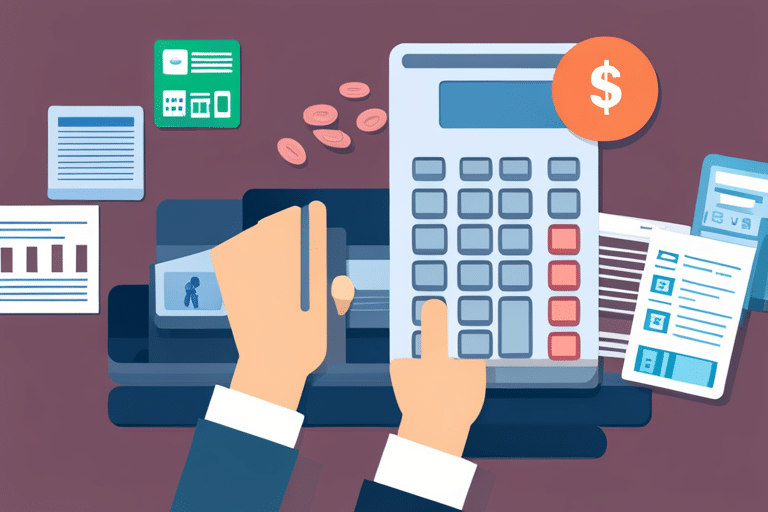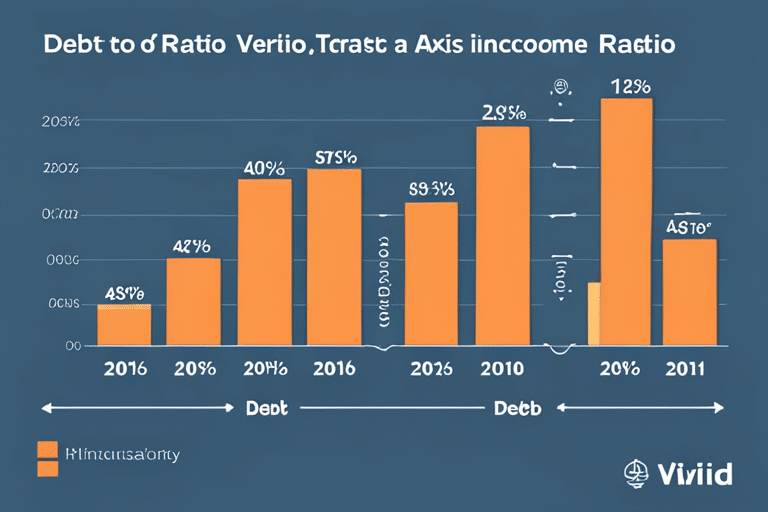You think you’ve got your finances under control, but do you really know the truth? The truth is, understanding your debt-to-income ratio is crucial if you want to master your financial destiny.
Don’t worry though, it’s not as complicated as it sounds. In fact, with a little knowledge and some simple calculations, you’ll be well on your way to financial freedom.
So buckle up and get ready to dive into the world of debt-to-income ratios – trust me, it’s a journey worth taking!
Key Takeaways
- Debt-to-income ratio is a key factor in determining financial health.
- A high ratio indicates spending a large portion of income on debts.
- Maintaining a healthy ratio is important for financial stability.
- Debt-to-income ratio helps guide you in managing your debts.
The Basics of Debt-To-Income Ratio

The debt-to-income ratio is a key factor in determining your financial health. It’s like the love child of math and finance, but with less algebra and more dollar signs. So, buckle up and get ready to dive into the wonderful world of calculating accuracy and interpreting results!
To calculate your debt-to-income ratio, you need to gather some information about your finances. This includes adding up all your monthly debt payments (like student loans or credit card bills) and dividing that by your gross monthly income (the money you make before Uncle Sam takes his cut). The result is a fancy percentage that tells you how much of your income is going towards paying off debts.
Now, let’s interpret those results! If your debt-to-income ratio is high, like trying to fit into skinny jeans after Thanksgiving dinner high, it means you’re spending a big chunk of your income on debts. This can be a sign that you’re living beyond your means and might want to reevaluate your spending habits.
On the other hand, if your ratio is low, like finding money in an old jacket pocket low, it means you have more wiggle room in your budget. You can use this extra cash to save for emergencies or treat yourself to that fancy coffee once in a while.
How to Calculate Your Debt-To-Income Ratio

To calculate your debt-to-income ratio, start by adding up all of your monthly debts and dividing it by your total monthly income. Sounds simple enough, right? But let’s dive in a little deeper and have some fun with numbers!
Here’s a handy table to help you visualize the process:
| Monthly Debts | Total Monthly Income | Debt-to-Income Ratio |
|---|---|---|
| $1000 | $4000 | 25% |
| $1500 | $5000 | 30% |
| $2000 | $6000 | 33.3% |
| $2500 | $7000 | 35.7% |
Calculating accuracy is key here, my friend. Make sure you include all of your debts – credit cards, student loans, car payments – everything! And don’t forget to include any additional sources of income as well.
Once you’ve crunched the numbers, it’s time for interpretation. The debt-to-income ratio represents the percentage of your monthly income that goes towards paying off debts. The lower the number, the better off you are financially.
If your ratio is on the higher side, it may be time to reassess your spending habits or explore ways to increase your income. Remember, this isn’t just about crunching numbers; it’s about gaining mastery over your financial health.
Understanding the Significance of Debt-To-Income Ratio

Wrap your mind around the importance of the debt-to-income ratio in managing your financial health.
Picture this: you’re a tightrope walker, balancing your finances with precision and grace. The debt-to-income ratio is like the pole that keeps you steady on that thin wire. It measures how much of your income goes towards paying off debt, and it’s crucial to understand its significance.
Now, let’s talk about the impact of a high debt-to-income ratio. Imagine trying to juggle ten flaming torches while riding a unicycle – not exactly an easy feat! A high ratio means you have more debt than income, which can make it difficult to meet your monthly obligations. It’s like trying to keep all those torches in the air without any fire-resistant gloves.
But fear not! There are strategies to reduce your debt and improve that ratio. Start by cutting back on unnecessary expenses – do you really need that daily latte or monthly subscription box? Next, consider consolidating your debts into one manageable payment. This way, you’ll have better control over where your money goes, just like a master puppeteer pulling all the right strings.
Guidelines for an Ideal Debt-To-Income Ratio

Hey there, money maestro! Today we’re diving into the magical world of debt-to-income ratios.
Yes, I know it sounds about as exciting as watching paint dry, but bear with me because understanding this ratio is key to financial wizardry.
We’ll be exploring how to find that optimal debt threshold and how your chosen ratio can make or break your financial health.
Importance of Ratio
Understanding your debt-to-income ratio is crucial because it determines whether you can afford to take on more debt. Think of it as a financial decision-making superhero, swooping in to save you from drowning in a sea of debt.
Picture this: you’re standing at the edge of a cliff, about to make a leap into the unknown world of debt management. But before you take that plunge, your trusty sidekick, the debt-to-income ratio, steps in and says, ‘Hold up there, buddy! Let’s check if you’ve got enough income to handle this new debt.’
It’s like having a personal financial advisor who knows all the ins and outs of your money situation. So next time you’re thinking about taking on more debt, remember to consult your superhero friend first – your bank account will thank you later!
Optimal Debt Threshold
Now that you understand the importance of your debt-to-income ratio, let’s dive into the world of optimal debt management and reducing your debt burden. It’s like being on a tightrope, balancing your debts without losing your balance!
Imagine yourself in a circus, juggling different types of debts while trying to maintain a smile on your face. Here are some tips to help you find the perfect balance:
- Prioritize high-interest debts first, like credit card balances or payday loans.
- Create a budget and stick to it religiously. No more impulsive purchases!
- Consider consolidating your debts into one lower-interest loan.
- Negotiate with creditors for better repayment terms.
- Seek professional advice from financial experts who can guide you through this circus act.
With these strategies in place, you’ll be well on your way to reducing your debt burden and achieving optimal debt management. But hold on tight because next, we’ll explore how all of this impacts your overall financial health!
Impact on Financial Health
To improve your financial health, it’s important to consider how managing your debt can have a positive impact on your overall well-being. Let’s face it – being in debt is like carrying around an extra weight that slows you down. But did you know that it can also affect your credit score, debt to income ratio, and even your retirement planning? It’s like a domino effect, my friend.
First off, having too much debt can lower your credit score faster than trying to juggle flaming torches blindfolded. And we all know how important that three-digit number is when it comes to borrowing money or getting a mortgage for that dream house of yours.
But wait, there’s more! Your debt-to-income ratio is another crucial factor that lenders take into consideration. If this ratio is out of whack, it could mean trouble for future loan applications or even raise eyebrows during job interviews (trust me, recruiters love snooping around).
And let’s not forget about retirement planning. The more debt you have hanging over your head like a dark cloud of regret, the harder it becomes to save for those golden years by the beach sipping margaritas (or whatever floats your boat). So if you want to retire in style and not live off ramen noodles until kingdom come, tackling that pesky debt should be high on your priority list.
Common Mistakes to Avoid When Analyzing Debt-To-Income Ratio

So you’ve got your debt-to-income ratio (DTI) all figured out, but now it’s time to dive into the nitty-gritty details.
Calculating an accurate DTI can be a bit like solving a complex math problem – except instead of numbers, you’re juggling bills and income.
And once you’ve crunched those numbers, interpreting the results is like deciphering the secret language of financial health.
But fear not! We’re here to guide you through this perplexing maze with our trusty compass of humor and creativity.
Calculating Accurate DTI
Calculating an accurate DTI is crucial in understanding your financial situation. So, let’s dive into the world of numbers and calculations! Here are five things you need to know about accurately calculating your DTI:
- Bust out the calculator: You’ll need to crunch some numbers to get an accurate calculation.
- Gather all the facts: Make sure you have all the information about your debts and income handy.
- Do the math: Divide your total monthly debt payments by your gross monthly income.
- Don’t forget the decimal point: Remember, we’re dealing with percentages here, so move that decimal two places to the right!
- Keep it up-to-date: Regularly recalculate your DTI as your financial situation changes.
Now that you’ve mastered the art of accurate DTI calculation, let’s move on to interpreting those results and unleashing the power of effective management.
Interpreting DTI Results
Now that you’ve accurately calculated your DTI, it’s time to interpret the results and understand what they mean for your financial situation.
Don’t worry, this isn’t rocket science! Think of interpreting DTI trends as deciphering a secret code that reveals valuable insights about your overall debt management.
Are you ready to dive in? Great!
First, let’s talk about interpreting DTI trends. Look at how your DTI has changed over time – is it going up or down? This will give you an idea of whether your debt is increasing or decreasing relative to your income.
Next, let’s analyze those DTI outliers. Are there any extreme spikes or drops? These could indicate significant changes in your financial circumstances.
Remember, the goal is to maintain a healthy balance between debt and income. So keep an eye on those trends and outliers!
Speaking of which, understanding the impact of debt-to-income ratio on loan applications is crucial…
The Impact of Debt-To-Income Ratio on Loan Applications

Understanding your debt-to-income ratio is crucial because it can heavily influence the outcome of your loan applications. Your DTI ratio is like a nosy neighbor that lenders use to determine if you’re a responsible borrower or just have an unhealthy obsession with avocado toast.
So, before you start dreaming about that shiny new car or tropical vacation, let’s dive into how your DTI ratio impacts loan approval and its relationship with your credit score.
Here are five things you need to know:
-
Approval or Rejection: A high DTI ratio may make lenders skeptical about granting you a loan because it suggests you’re already drowning in debt.
-
Interest Rates: If your DTI ratio is low, lenders may offer lower interest rates as they see you as financially stable and less risky.
-
Credit Score Connection: Your DTI ratio and credit score are like two peas in a pod. A high DTI can negatively impact your credit score, making it harder to secure loans in the future.
-
Debt Management: Maintaining a healthy DTI ratio shows potential lenders that you can manage your debts responsibly.
-
Room for Growth: By understanding and actively managing your DTI ratio, you’ll have more control over your financial future and be better positioned for future loan opportunities.
Debt-To-Income Ratio and Mortgage Approval

To increase your chances of getting approved for a mortgage, it’s important to keep your debt-to-income ratio within an acceptable range. You may be wondering, ‘What on earth is a debt-to-income ratio?’ Well, my friend, let me break it down for you in the most entertaining way possible.
Imagine you’re at a fancy restaurant, and the waiter arrives with a towering plate of food. You take one look and realize there’s no way you can finish it all without feeling like a balloon about to burst. That’s exactly how your debt-to-income ratio works. It measures how much debt you have compared to your income, kind of like measuring how much food is on your plate compared to the size of your stomach.
Now, if you want to improve your mortgage affordability and gobble up that dream home without feeling financially stuffed, you might consider some debt consolidation magic. It’s like hiring a professional organizer for your debts – they’ll whip them into shape and make them more manageable.
But hold on just a second! Before we dive into the world of debt consolidation and creditworthiness, let’s first understand how this debt-to-income ratio affects our ability to secure that sweet mortgage deal. So strap in tight because we’re about to embark on an educational journey through financial land!
In the next section, we’ll explore how this ratio impacts not only our creditworthiness but also our overall financial well-being. Get ready for some eye-opening insights!
Debt-To-Income Ratio and Creditworthiness

Hey there, savvy borrower! Let’s talk about the importance of keeping your debt-to-income ratio low and how it can affect your eligibility for loans.
Picture this: you’re at a fancy restaurant, eyeing their decadent dessert menu. But hold up! Your debt-to-income ratio is like that extra slice of cake – too much and things get messy.
Importance of Low Ratio
Having a low debt-to-income ratio is crucial because it shows lenders that you are financially responsible and capable of managing your debts. Plus, who doesn’t want to impress those money people? So, let’s dive into the importance of maintaining a low ratio:
-
Better Loan Approval Chances: A low debt-to-income ratio makes lenders go weak in the knees and increases your chances of getting approved for loans.
-
Lower Interest Rates: When your ratio is low, lenders see you as less risky. And less risk means lower interest rates. Cha-ching!
-
Improved Financial Flexibility: With a low debt-to-income ratio, you’ll have more wiggle room in your budget to save, invest, or splurge on that fancy avocado toast.
-
Stress-Free Finances: Say goodbye to sleepless nights worrying about overwhelming debts. A low ratio means manageable payments and peace of mind.
-
Pathway to Financial Freedom: By keeping your debt-to-income ratio in check, you’re paving the way towards financial freedom and building a solid foundation for future success.
Impact on Loan Eligibility
Maintaining a low debt-to-income ratio significantly impacts your eligibility for loans. It’s like having a secret weapon in the world of lending. You see, lenders want to know that you’re responsible with your finances and won’t default on payments faster than a cheetah chasing its prey. So, when they see that your debt-to-income ratio is low, they’ll be more inclined to trust you with their hard-earned cash.
Not only does it affect loan eligibility, but it also has an impact on your credit score and loan interest rates. The lower your debt-to-income ratio, the higher your credit score will be. Picture yourself as the captain of a ship sailing smoothly through calm waters while others struggle against rough tides.
Furthermore, this low ratio can also help you secure lower interest rates on loans. It’s like finding out that you have access to an exclusive VIP lounge at a crowded airport – you get all the perks without paying those exorbitant prices.
Strategies to Improve Your Debt-To-Income Ratio

To improve your debt-to-income ratio, you should consider increasing your income or reducing your debt.
Let’s face it, nobody likes the idea of being in debt. It’s like having a clingy ex who won’t leave you alone.
So here are some creative and humorous strategies to help you kick that debt to the curb and improve your financial situation:
-
Get a side hustle: Have you ever considered becoming a professional dog walker? Or maybe starting a YouTube channel dedicated to reviewing different flavors of potato chips? The possibilities are endless! Find something you enjoy doing and turn it into an extra source of income.
-
Cut back on unnecessary expenses: Do you really need that fancy coffee every morning? And do those designer shoes actually make you run faster? Probably not. Take a hard look at your spending habits and try to eliminate any unnecessary expenses.
-
Negotiate with creditors: Did you know that sometimes, if you ask nicely, creditors might be willing to lower your interest rates or even forgive part of your debt? It never hurts to ask!
-
Create a budget: Ah, the dreaded B-word. But trust me, creating a budget can actually be fun! Okay fine, maybe not fun but definitely necessary. Track your income and expenses so you can see where every penny is going.
-
Snowball method: No, I’m not talking about building snowmen (although that does sound like fun). The snowball method involves paying off your smallest debts first while making minimum payments on the larger ones. Once one debt is paid off, move onto the next one until they’re all gone!
Debt-To-Income Ratio and Financial Stability

If you want to achieve financial stability, it’s important to assess your debt-to-income ratio regularly. Your debt-to-income ratio is like the relationship status between your debts and your income. Are they happily coexisting or locked in a perpetual battle? Let’s take a look at how this ratio can impact your financial well-being.
Take a peek at the table below for a visual representation of the debt-to-income ratio and its effect on your life choices:
| Debt-to-Income Ratio | Relationship Status | Career Choices |
|---|---|---|
| 0-20% | Living the dream! | Unlimited |
| 21-35% | It’s complicated | Some restrictions apply |
| 36-49% | In a rocky phase | Limited options ahead |
| 50%+ | It’s over | Say hello to financial stress |
As you can see, maintaining a low debt-to-income ratio allows for unlimited career choices and financial freedom. On the other hand, as this ratio increases, so do the restrictions on what you can do with your life.
Debt-To-Income Ratio and Budgeting

When budgeting, it’s essential to consider how your debt-to-income ratio impacts your financial decisions. Your debt-to-income ratio is like that friend who always brings drama to the party – it can either make or break your financial stability. So, let’s dive into how this little number affects your budgeting game.
Here are five ways your debt-to-income ratio influences your budget:
-
Credit card usage: If you have a high debt-to-income ratio, it might be tempting to rely on credit cards for everyday expenses. But beware! This can lead to a never-ending cycle of debt and interest payments.
-
Saving habits: A high debt-to-income ratio means you have less money left over each month for saving. It’s like trying to fill a leaky bucket – no matter how much water you pour in, it keeps draining out.
-
Financial goals: Whether it’s buying a house or starting a business, achieving financial goals becomes harder with a high debt-to-income ratio. It’s like trying to climb Mount Everest with an extra-heavy backpack – not impossible but definitely more challenging.
-
Emergency fund: Having an emergency fund is crucial for unexpected expenses. But with a high debt-to-income ratio, building up that safety net becomes even trickier. It’s like playing Jenga while blindfolded – one wrong move and everything comes crashing down.
-
Peace of mind: Lastly, having a low debt-to-income ratio allows you to breathe easy and sleep better at night. You don’t want those late-night panic attacks about bills haunting your dreams!
Understanding how your debt-to-income ratio affects your budgeting decisions is key to maintaining financial stability and achieving long-term goals. So buckle up (but not too tightly) as we explore the relationship between the debt-to-income ratio and long-term financial planning in the next section!
Debt-To-Income Ratio and Long-Term Financial Planning

So, you’ve mastered the art of budgeting and have a solid understanding of your debt-to-income ratio. Well done, my friend! Now let’s take it a step further and talk about how this magical ratio can help you achieve those long-term financial goals.
Managing debt effectively is crucial when it comes to achieving financial success in the long run. And your trusty debt-to-income ratio is here to guide you on this path. You see, by keeping an eye on this little number, you can ensure that your debts don’t spiral out of control and hinder your progress towards those lofty goals.
Let’s say you’re eyeing that dream house or planning for retirement. By managing your debts effectively and maintaining a healthy debt-to-income ratio, you’ll be well on your way to turning those dreams into reality. Plus, with a lower amount of debt weighing you down, you’ll have more flexibility in making investments or saving for the future.
But remember, my dear master of finances, achieving long-term financial goals requires careful monitoring and adjustment along the way. So buckle up as we dive deeper into the fascinating world of monitoring your debt-to-income ratio over time…
Monitoring Your Debt-To-Income Ratio Over Time

Monitoring your debt-to-income ratio over time is key to maintaining financial stability and achieving long-term goals. But who wants to be bored by numbers all the time? Not you! So, let’s make tracking changes in your debt-to-income ratio a fun adventure.
Here are five ways to keep an eye on that pesky number while having a good laugh:
-
Use a colorful graph: Who said finance had to be black and white? Add some pizzazz with a vibrant chart that shows your progress.
-
Set up alerts: Let technology do the work for you. Get notified when your debt-to-income ratio reaches certain thresholds, so you can celebrate or take action accordingly.
-
Create a rewards system: Treat yourself every time you see improvement in your ratio. Maybe it’s a fancy coffee or a night out with friends – whatever brings you joy!
-
Gamify it: Turn tracking into a game by challenging yourself to lower your ratio each month. The winner gets bragging rights and maybe even a small prize.
-
Join forces: Find an accountability partner who also wants to monitor their debt-to-income ratio. Together, you can share tips, motivate each other, and laugh at the ups and downs.
Frequently Asked Questions
Can Having a High Debt-To-Income Ratio Affect My Ability to Get a Job?
Having a high debt-to-income ratio can definitely impact your job prospects. Employers often consider financial stability when making hiring decisions, so it’s crucial to keep that ratio in check for better employment opportunities.
How Does a High Debt-To-Income Ratio Impact My Credit Score?
Having a high debt-to-income ratio can seriously mess with your credit score. It’s like bringing a water gun to a flamethrower fight. The consequences are no joke, so get that ratio in check!
Is It Possible to Have a Low Debt-To-Income Ratio but Still Have Financial Difficulties?
Having a low debt-to-income ratio doesn’t guarantee financial smooth sailing. Unexpected expenses, job loss, or poor budgeting can still create hardships. It’s important to consider all factors affecting your debt-to-income ratio.
Can My Debt-To-Income Ratio Change Over Time? if So, What Factors Can Cause It to Change?
Hey, you! Can your debt-to-income ratio change over time? Absolutely! Factors like new loans, pay raises, or losing a job can shake things up. So keep an eye on it and stay balanced!
Are There Any Exceptions to the General Guidelines for an Ideal Debt-To-Income Ratio?
Exceptions to the general guidelines for an ideal debt-to-income ratio? Well, let’s just say that if your DTI is off the charts, your job prospects may be as well. Time to reassess those financial decisions!
Conclusion
Congratulations! You’ve unlocked the secret to understanding your debt-to-income ratio. Like a wise wizard wielding a financial wand, you can now calculate this magical number and harness its power.
Remember, it’s not just about numbers on a page; your debt-to-income ratio holds the key to financial stability and long-term planning.
So, keep an eye on that enchanting ratio as you journey through life, making smart budgeting decisions and avoiding the treacherous pitfalls of overspending.
May your debt-to-income ratio always be in your favor!

